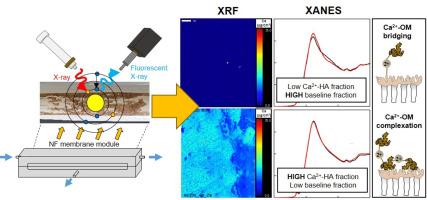Calcium-organic matter fouling in nanofiltration: Synchrotron-based X-ray fluorescence and absorption near-edge structure spectroscopy for speciation
IF 12.4
1区 环境科学与生态学
Q1 ENGINEERING, ENVIRONMENTAL
引用次数: 0
Abstract
Calcium (Ca)-enhanced organic matter (OM) fouling of nanofiltration (NF) membranes leads to reduced flux during desalination and requires frequent cleaning. Fouling mechanisms are not fully understood, which limits the development of targeted fouling control methods. This study employed synchrotron-based X-ray fluorescence (XRF) and X-ray absorption near-edge structure (XANES) spectroscopy to quantify the spatial distribution and mass of Ca deposition as well as changes in the Ca coordination environment characteristic of specific fouling mechanisms, respectively. Bench-scale filtration experiments were performed using feed solutions containing Ca and ten different types of organic matter (OM), as well as the common scalants, calcium carbonate (CaCO3) and calcium sulfate (CaSO4). Osmotic backwash (OB) was performed at regular intervals for fouling control. Ca-OM aggregation resulted in greater flux decline and lower flux recovery during OB than Ca conditioning of membranes followed by filtration of feed solution with OM. Linear combination fitting (LCF) of XANES absorption spectra from fouled membranes indicated that Ca-OM aggregation preferentially occurred for OM types that exhibited both high carboxylic group and negative charge density. Consequently, these OM types exhibited greater deposition of Ca and TOC on the membrane surface when compared to other OM types. For the coexistence of scalants and OM, Ca speciation within the fouling layer was characteristic of both Ca bound to the membrane (i.e. potential bridging, charge screening) as well as Ca-OM aggregation and deposition mechanisms, while a range of crystal polymorphs were observed to occur simultaneously. XRF and XANES represent powerful tools for the elucidation of NF fouling mechanisms by quantification of Ca deposition as well as Ca speciation. Fouling control methods should target OM types with high carboxyl group density and negative charge to neutralize or eliminate interactions with Ca.


纳滤中的钙-有机物污染:基于同步加速器的x射线荧光和吸收近边结构光谱的物种形成
纳滤(NF)膜的钙(Ca)增强有机物(OM)污染导致海水淡化过程中通量降低,需要经常清洗。污染机理尚未完全了解,这限制了有针对性的污染控制方法的发展。本研究采用基于同步加速器的x射线荧光(XRF)和x射线吸收近边结构(XANES)光谱分别量化了Ca沉积的空间分布和质量,以及特定结垢机制下Ca配位环境特征的变化。采用含Ca和10种不同类型有机物(OM)的饲料溶液,以及常见的洗垢剂碳酸钙(CaCO3)和硫酸钙(CaSO4)进行了实验。定期进行渗透反冲洗(OB)以控制污垢。相比于对膜进行Ca调理后再用OM过滤,在OB过程中Ca-OM的聚集导致了更大的通量下降和更低的通量恢复。污染膜XANES吸收光谱的线性组合拟合(LCF)表明,具有高羧基和负电荷密度的OM类型优先发生Ca-OM聚集。因此,与其他类型的OM相比,这些OM类型在膜表面表现出更多的Ca和TOC沉积。对于垢垢剂和OM的共存,垢层内Ca的形成既具有Ca与膜的结合(即电位桥接、电荷筛选)的特征,也具有Ca-OM的聚集和沉积机制,同时观察到一系列晶体的多晶态同时发生。XRF和XANES是通过量化Ca沉积和Ca形态来阐明NF污染机制的有力工具。污垢控制方法应针对具有高羧基密度和负电荷的OM类型,以中和或消除与Ca的相互作用。
本文章由计算机程序翻译,如有差异,请以英文原文为准。
求助全文
约1分钟内获得全文
求助全文
来源期刊

Water Research
环境科学-工程:环境
CiteScore
20.80
自引率
9.40%
发文量
1307
审稿时长
38 days
期刊介绍:
Water Research, along with its open access companion journal Water Research X, serves as a platform for publishing original research papers covering various aspects of the science and technology related to the anthropogenic water cycle, water quality, and its management worldwide. The audience targeted by the journal comprises biologists, chemical engineers, chemists, civil engineers, environmental engineers, limnologists, and microbiologists. The scope of the journal include:
•Treatment processes for water and wastewaters (municipal, agricultural, industrial, and on-site treatment), including resource recovery and residuals management;
•Urban hydrology including sewer systems, stormwater management, and green infrastructure;
•Drinking water treatment and distribution;
•Potable and non-potable water reuse;
•Sanitation, public health, and risk assessment;
•Anaerobic digestion, solid and hazardous waste management, including source characterization and the effects and control of leachates and gaseous emissions;
•Contaminants (chemical, microbial, anthropogenic particles such as nanoparticles or microplastics) and related water quality sensing, monitoring, fate, and assessment;
•Anthropogenic impacts on inland, tidal, coastal and urban waters, focusing on surface and ground waters, and point and non-point sources of pollution;
•Environmental restoration, linked to surface water, groundwater and groundwater remediation;
•Analysis of the interfaces between sediments and water, and between water and atmosphere, focusing specifically on anthropogenic impacts;
•Mathematical modelling, systems analysis, machine learning, and beneficial use of big data related to the anthropogenic water cycle;
•Socio-economic, policy, and regulations studies.
 求助内容:
求助内容: 应助结果提醒方式:
应助结果提醒方式:


